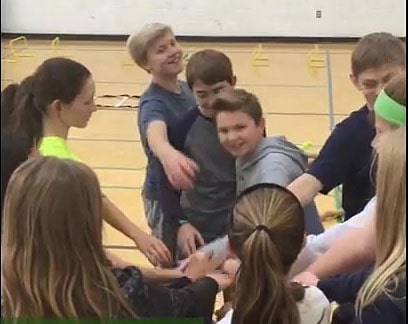High-intensity interval training (HIIT) activity continue to grow in popularity for students as teachers work to create PE classes that address students’ physical, mental and emotional health.
“I think students overall like this type of class better than your traditional, old school, physical education class,” said Lunenburg (Mass.) High School PE teacher Steve Boone. “I think they like individual workouts.”
Getting his students more engaged through vigorous physical activity is just one of the benefits of incorporating HIIT training into his classes. Students continue to prove that HIIT workouts also increase brain development, particularly in middle and high school students.
In July 2022, Australian professor David Lubans studied 56 older adolescents and determined that subjects who completed two HIIT sessions per week showed increases in two markers of brain metabolic activity on a post-test brain scan.
“Participating in physical activity of vigorous intensity for a relatively short period of time appears to simulate brain growth in older adolescents,” Lubans told PsyPost.
Lubans’ study also determined that HIIT resulted in stress reductions for students who were classified as obese or overweight. The results, he said, stress that schools should continue to provide opportunities for physical activity during the day – high-intensity physical activity in particular.
“I have found that providing evidence for the benefits of physical activity for academic outcomes, including test performance, cognitive function and on-task behavior in the classroom provides a strong impetus for schools to provide additional activity for young people,” he said.
Lubans’ findings strengthen the changes that Boone and other teachers have made in their programs over time, moving away from team sports and game play to programs that focus on circuits and tabatas. One of Boone’s most popular lessons is a circuit that encourages students to exercise at high intensity for quick bursts of time.
Depending on the age and ability of his students, Boone’s circuit – also referred to as a Tabata – requires that participants see how many high-intensity repetitions they can perform in 20 seconds at eight different stations.
“This seems to be what works the best with what we’re trying to get out of the kids,” Hampstead (NH) Middle School health and PE teacher Kate Muskrat said. “This tailors to an individual’s needs instead of some of the other things we’ve tried. (HIIT) just seems like something that allows everyone to achieve greatness.”
The concept keeps students moving and prevents them from struggling to perform an exercise they don’t like or struggle with.
“Hopefully, at some point, at one of those stations or at a few of them, you have something that you are really good at or find something that you really enjoy doing,” said Craig MacDerment, a physical education teacher at Shelburne (Vt.) Community School. “In a traditional game, if you spend 30 minutes playing a game that you don’t like, you’re really not going to get much out of it.”
Despite spending short periods of time exercising at high intensity levels, students find success based on the IHT ZONE heart rate monitors they wear during class.
“We use the IHT ZONE monitors and it has been an unbelievable motivational thing for them. It pushed them,” Boone said. “They check out their results after class.”
High-intensity circuits for all ages
MacDerment, along with colleague Kelly Spreen, devised a circuit workout for their elementary and middle school students that doesn’t move quite as quickly as Boone’s workout does with his high schoolers or adult education participants, but the objective the same: to maximize performance and reach class goals. Students wear heart rate monitors on their wrist and strive to stay in target heart rate zones for the duration of their workout.
Shelburne’s young students spend three minutes on a station working on different skills. During each rest period between exercises, students practice implementing a positive classroom culture by delivering compliments and encouragement to classmates.
Boone’s circuit starts with a 20-second burst to perform as many high-intensity reps as possible and then progresses:
- 10 seconds to make it to the next station and begin that exercise
- Repeat process of 20 seconds on, 10 seconds off through each station to complete the full circuit
- 60 seconds recovery time after each circuit before beginning the next rotation
By delivering workouts that mirror the HIIT philosophy, teachers show students how they can go through a strenuous, fitness-improving workout without spending a great deal of time doing it. In some studies, including McMaster University (Canada) study featured in the New York Times, exercising at maximum intensity provides the same health benefit as exercising for 45 minutes at a moderate intensity level.
“If you are someone, like me, who just wants to boost health and fitness and you don’t have 45 minutes or an hour to work out,” said Martin Gibala, a McMaster University professor who oversaw the study, “our data show that you can get big benefits from even a single minute of intense exercise.”




